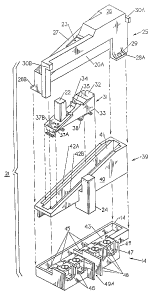Note: Claims are shown in the official language in which they were submitted.
-7-
CLAIMS:
1. An electric disconnect switch comprising:
a rectangular case;
a cover hinged to said case;
a plastic terminal block within said case, said terminal block
including a plurality of busbar contacts connecting with a plurality of
terminal lugs arranged on a terminal support;
a handle operator having a plurality of contact blades
extending from a bottom surface slidably arranged on said terminal block
and a handle post extending upwards from a top surface, said contact
blades moving in and out of contact with said busbar contacts in
response to manual movement of said handle posts between ON and OFF
positions;
a plastic face plate arranged over said terminal support to
electrically isolate said terminal lugs; and
a plastic support housing arranged over said handle
operator, said support housing comprising a planar top and a central
ramp extending from said top at a predetermined acute angle, said central
ramp including a rectangular handle access slot, said handle post
extending within said handle access slot, said handle operator including
a contact spring extending from a top surface, said contact spring
interacting with a bottom surface of said support housing top to provide
contact pressure between said contact blades and said busbar contacts
when said handle post is in an ON position.
2. The disconnect switch of claim 1, wherein said handle
operator comprises a triangular body.
3. The disconnect switch of claim 1, wherein said support
housing includes a rectangular side coextensive with said central ramp,
-8-
said support housing top and said support housing side each including
integral tabs supporting one end of said face plate.
4. The disconnect switch of claim 1, wherein, said contact
spring comprises a planar end and an angulated end, said planar end
being fastened to said handle operator top surface and said angulated
end extending up-right from said handle operator top surface.
5. An electric disconnect switch comprising:
a rectangular case;
a cover hinged to salt case;
a plastic terminal block within said case, sad terminal block
including a plurality of busbar contacts connecting with a plurality of
terminal lugs arranged on a terminal support;
a handle operator having a plurality of contact blades
extending from a bottom surface slidably arranged on said terminal block
and a handle post extending upwards from a top surface, said contact
blades moving in and out of contact with said busbar contacts in response
to manual movement of said handle post between ON and OFF positions;
a plastic face plate arranged over said terminal support to
electrically isolate said terminal lugs; and
a plastic handle operator guide comprising a triangular body
having a ramped elongated rectangular handle support slot, said handle
post being arranged within said handle support slot.
6. The disconnect switch of claim 5, wherein said handle
operator further includes a planar apron supporting said handle post, said
apron defining a pair of runners extending from opposite edges and
arranged on a corresponding pair of tracks integrally-formed on opposite
sides of said handle support slot.
-9-
7. The disconnect switch of claim 5, wherein said triangular
body further includes a locking block integrally-formed on one side
thereof.
8. The disconnect switch of claim 7, wherein said terminal
support includes a plurality of terminal compartments, a central one of
said compartments receiving said locking block in press-fit relation.
9. The disconnect switch of claim 5, wherein said terminal
block further includes an upstanding perimetric wall defining a rectangular
cavity, said busbar contacts being recessed within said cavity.
10. The disconnect switch of claim 9, including a plurality of
upstanding barriers intermediate said terminal compartments electrically
isolating said terminal lugs.
11. The disconnect switch of claim 5, wherein said case is
metal.
12. The disconnect switch of claim 5, wherein said cover is
metal.
